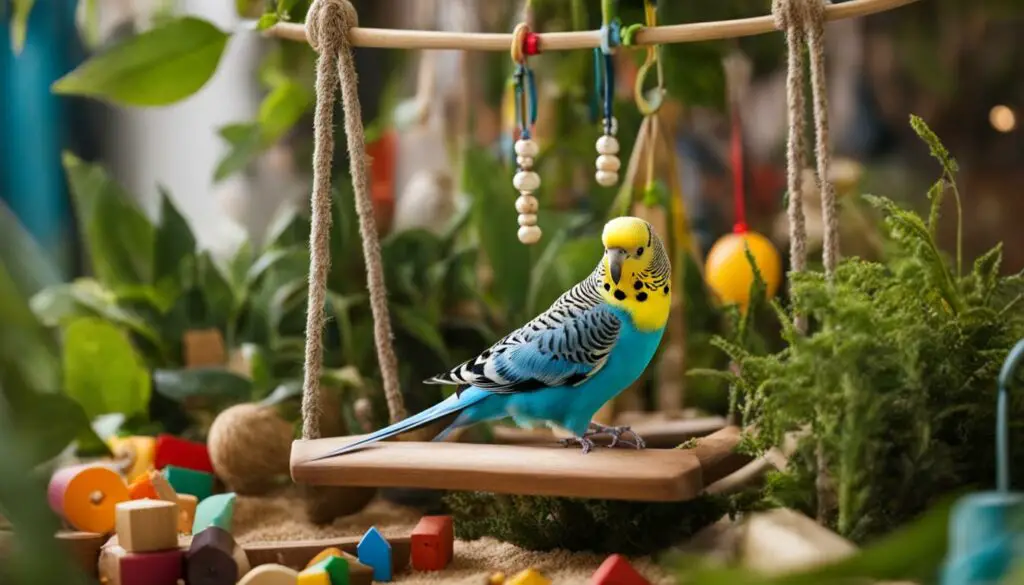As a budgie owner, I know how important it is to provide my feathered friend with fun and engaging playtime activities. Budgies are social and active birds that require interactive play to stay happy and healthy. By incorporating various playtime options, you can keep your budgie mentally stimulated and physically active. Let’s explore some exciting budgie playtime activities, favorite toys, and enrichment ideas to keep your pet entertained for hours!
Key Takeaways:
- Budgies need interactive playtime activities for mental stimulation and physical exercise.
- Foraging is a natural and interactive activity that stimulates budgies’ curiosity.
- Climbing and perching opportunities keep budgies active and entertained.
- Socialization and training help strengthen the bond with your budgie and provide mental stimulation.
- Playful accessories like swings, mirrors, and bells add extra fun to your budgie’s playtime.
Foraging
Foraging is a natural and interactive activity for budgies that stimulates their instincts and engages their minds. By incorporating foraging into their playtime, you can provide mental stimulation and enrichment for your feathered friend. One way to encourage foraging is by hiding small pieces of food around their cage or play area. This allows them to explore and search for the hidden treats, replicating the thrill of finding food in the wild.
To make foraging even more enjoyable, you can utilize foraging toys specifically designed for budgies. These toys often feature compartments or puzzles that require the bird to work to access the food inside. This not only engages their foraging instincts but also provides a fun and interactive challenge. Puzzle feeders, rotating treat dispensers, and food puzzles are popular choices that can keep your budgie entertained for hours.
By incorporating foraging activities and toys into your budgie’s playtime routine, you can provide them with both physical and mental stimulation. Not only does it keep them entertained, but it also helps prevent boredom and encourages natural behaviors. So don’t forget to include some foraging fun in your budgie’s playtime activities!

Benefits of Foraging for Budgies
Foraging is a natural behavior for budgies and provides several benefits:
- Mental Stimulation: Foraging engages their problem-solving skills and keeps their minds active.
- Physical Exercise: Searching for hidden treats encourages movement and keeps them physically fit.
- Prevents Boredom: Foraging activities provide an exciting and entertaining challenge, preventing boredom and associated negative behaviors.
- Natural Instincts: Foraging taps into their natural instincts and allows them to engage in a behavior similar to what they would do in the wild.
Overall, foraging is a fun and beneficial activity for budgies that enhances their well-being and happiness. So why not incorporate some foraging toys and activities into your budgie’s playtime routine?
Climbing and Perching
Budgies are active birds that love to climb and perch. Providing them with a variety of climbing toys, perches, and ladders is important for their physical well-being and mental stimulation.
Climbing toys, such as ladders and rope bridges, offer budgies opportunities to exercise, explore, and satisfy their natural instincts. These toys can be placed in different areas of the cage or play area to keep your budgie engaged and entertained. Additionally, perches of different sizes and textures should be provided to promote foot and leg health.
It’s important to ensure that the climbing toys are securely attached and do not pose any safety risks for your budgie. Opt for toys made from bird-safe materials, such as stainless steel or untreated wood. Regularly inspect the toys for any signs of damage or wear and replace them as needed.
By providing a stimulating environment with climbing toys and perches, you can keep your budgie physically active and mentally stimulated. Remember to observe and interact with your budgie during playtime to ensure their safety and well-being.
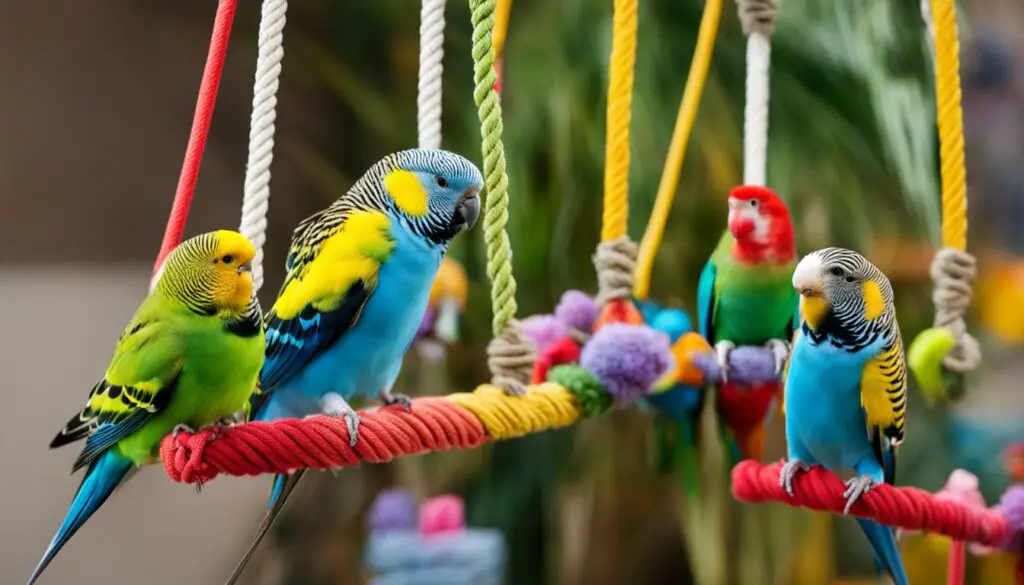
Benefits of Climbing and Perching for Budgies
- Physical exercise: Climbing and perching help budgies strengthen their muscles and improve their coordination and balance.
- Mental stimulation: Engaging in climbing activities challenges budgies’ problem-solving skills and provides mental stimulation.
- Foot and leg health: Different perches of varying textures help keep budgies’ feet and legs healthy by preventing pressure sores and promoting blood circulation.
- Natural behavior: Climbing and perching are natural behaviors for budgies, and providing them with these opportunities allows them to engage in their instinctual activities.
Socialization and Training
Budgies are highly social birds that thrive on interaction and training. Spending quality time with your budgie not only strengthens your bond but also provides mental stimulation and enrichment. Here are some tips for socializing and training your budgie:
- Regular Handling: It’s important to handle your budgie gently and regularly to build trust and familiarity. Start with short sessions and gradually increase the duration as your budgie becomes more comfortable. Use positive reinforcement, such as treats or praises, to reward calm and cooperative behavior.
- Teaching Simple Tricks: Budgies are intelligent and can learn a variety of tricks. Start with simple commands like “step up” or “turn around.” Use treats as rewards and be patient during the training process. Consistency and repetition are key to success.
- Interactive Play: Engage your budgie in interactive play sessions using toys, such as small balls or puzzle toys. Encourage them to chase or retrieve the toys and reward their efforts with treats and praises. This not only keeps them mentally stimulated but also helps to burn off excess energy.
- Positive Reinforcement: Positive reinforcement is crucial in budgie training. Use treats, praises, and gentle strokes to reward desired behaviors. Avoid punishment or harsh handling, as it can be detrimental to your budgie’s trust and overall well-being.
Remember that each budgie has its own personality and learning pace. Be patient and understanding during the training process. Consistency, positive reinforcement, and a loving approach will help your budgie develop new skills and strengthen your bond.
Expert Tip: An Enriching Environment
“Creating an enriched environment for your budgie is key to socialization and training success. Provide a variety of toys, perches, and interactive objects to keep your budgie engaged and mentally stimulated. Rotate the toys regularly to prevent boredom. Additionally, consider placing the budgie’s cage in a central location, such as the living room, where they can observe and interact with family members throughout the day.” – Dr. Avian, Avian Behaviorist
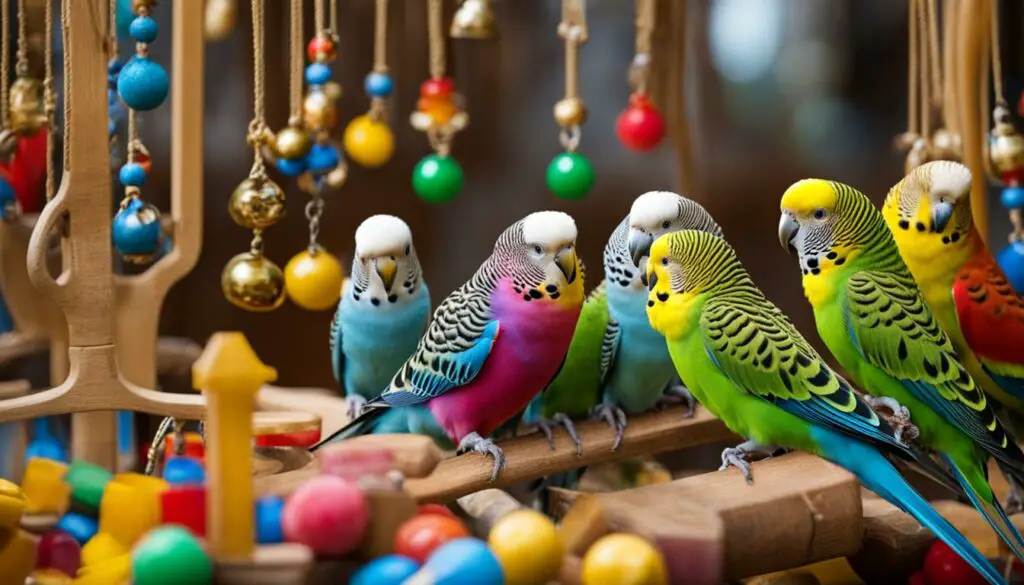
Table: Recommended Tricks for Budgie Training
| Trick | Description |
|---|---|
| Step Up | Teaching your budgie to step onto your finger or a perch. |
| Turn Around | Training your budgie to rotate in a circle on command. |
| Wave | Teaching your budgie to wave its foot or wing in response to a cue. |
| Play Dead | Training your budgie to lie down and stay still on command. |
Playful Accessories
When it comes to keeping your budgie entertained, playful accessories can make a big difference. Small swings, mirrors, and bells are popular options that can add a touch of fun to their environment. A swing not only offers a chance for exercise and play but also provides a cozy spot for your budgie to relax. Mirrors can be used for entertainment as your budgie admires their reflection and even offers a sense of companionship. Just be sure to supervise interactions with mirrors to prevent any potential aggression.
Bells, on the other hand, provide interactive stimulation. The sound and movement of a bell can capture your budgie’s attention and keep them engaged. Choose bells that are safe for birds, with no small parts that could be swallowed. Keep in mind that some budgies may be scared of loud noises, so choose a bell with a softer sound if your bird seems timid.
As with any accessory, it’s important to ensure that they are safe for your budgie to use. Check for any sharp edges or small parts that could be hazardous. Remove any toys or accessories that show signs of wear and tear. Remember, the safety and well-being of your budgie are top priorities.
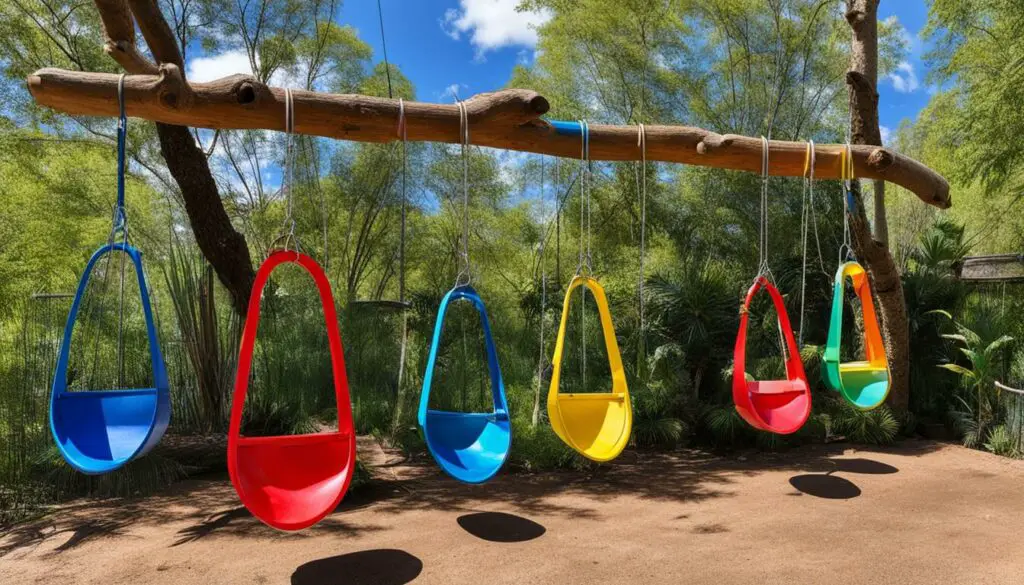
| Accessory | Description |
|---|---|
| Budgie Swing | A small swing that provides exercise and relaxation for your budgie. |
| Budgie Mirror | A mirror that offers entertainment and a sense of companionship for your budgie. |
| Budgie Bell | A bell that provides interactive stimulation and captures your budgie’s attention. |
By incorporating playful accessories into your budgie’s environment, you can provide them with additional entertainment and stimulation. Just remember to choose safe and appropriate options that suit your budgie’s preferences. With the right accessories, your budgie will have endless hours of fun and enjoyment.
Out of Cage Time: Let Your Budgie Spread Its Wings and Explore
As a budgie owner, it is important to provide your feathered friend with plenty of out of cage time. Budgies are natural flyers and explorers, and allowing them to stretch their wings and roam outside their enclosure is essential for their physical and mental well-being. Whether it’s supervised time in a bird-safe room or outdoor adventures on a harness and leash, out of cage time is an opportunity for your budgie to engage in natural behaviors and explore its surroundings.
During out of cage time, your budgie can enjoy the freedom of flight. Flying not only provides exercise but also helps to strengthen its flight muscles and promotes a sense of independence. It’s important to create a safe and secure environment to minimize the risk of accidents or escapes. Ensure that all windows and doors are closed, and remove any hazards or toxic plants from the area. Supervise your budgie closely, especially if it is its first time outside the cage, and gradually increase the duration of these sessions to allow your budgie to become more comfortable with its surroundings.
Exploration is an inherent part of a budgie’s nature, and out of cage time allows it to satisfy its curiosity. Whether it’s investigating new toys, perches, or even interacting with other pets in the household, these experiences provide mental stimulation and prevent boredom. You can enhance your budgie’s exploration by creating a bird-safe play area filled with toys, branches, and interactive puzzles. Encourage your budgie to explore different heights and textures by placing perches and climbing structures in the play area. This will keep your budgie engaged and provide opportunities for it to exercise and play.
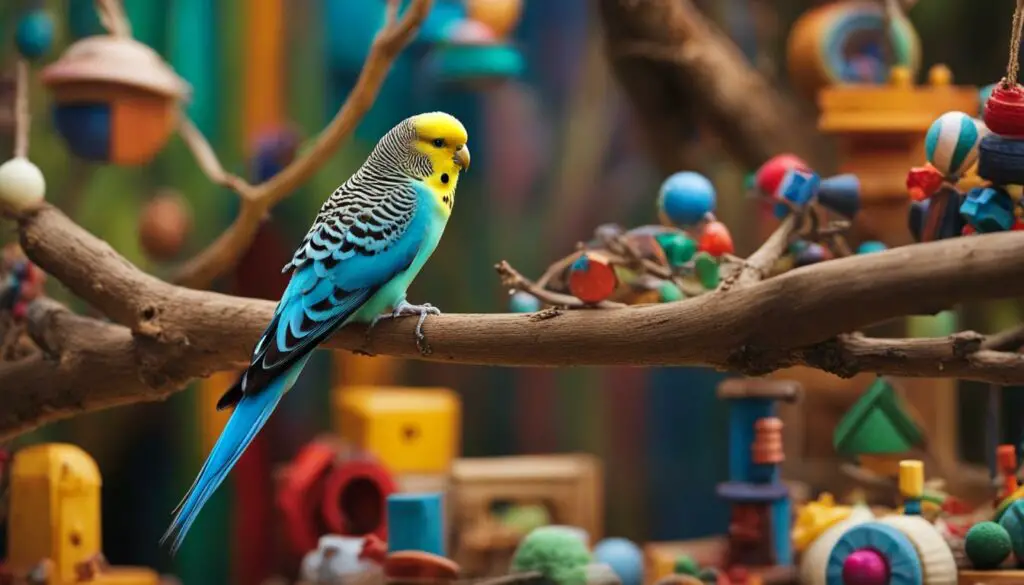
Remember, budgies are social creatures, and out of cage time also allows for bonding and interaction with their human family. Use this time to talk, sing, and play games with your budgie. Offer treats as rewards for positive behaviors, which will reinforce the bond between you and your feathered companion. By providing regular out of cage time, you are giving your budgie the opportunity to thrive, both physically and mentally.
Creating a Stimulating Environment
Creating a stimulating environment is crucial for keeping budgies entertained. As social and active birds, they require a variety of toys, perches, and items to explore. Incorporating natural elements such as branches, leaves, and rocks can add an extra touch of authenticity to their surroundings.
When it comes to toys, budgies enjoy a range of options. Swings provide a chance for exercise and play, while mirrors can offer entertainment and companionship. Bells provide interactive stimulation, and puzzle toys encourage mental stimulation and exploration. It’s important to choose toys that are safe for your budgie to use and supervise their interactions, especially with mirrors.
Another essential element of a stimulating environment for budgies is the placement of perches. By offering perches of different sizes and shapes, you can encourage movement and engagement. Creating a variety of heights and textures within the cage or play area will keep your budgie active and entertained. Consider incorporating ladders and rope bridges as well to provide additional climbing opportunities.
“A stimulating environment is key to keeping budgies happy and healthy.”
Table: Examples of Budgie Toys and Perches
| Toy/Perch | Description |
|---|---|
| Swing | A small swing for exercise and play |
| Mirror | A mirror for entertainment and companionship |
| Bell | An interactive bell for stimulation |
| Puzzle Toy | A toy that encourages mental stimulation and exploration |
| Perch | A variety of perches of different sizes and textures for climbing and perching |
| Ladder | A ladder for additional climbing opportunities |
By creating a stimulating environment with a variety of toys, perches, and natural elements, you can provide your budgie with the mental and physical stimulation they need to thrive. Keep in mind that budgies are intelligent creatures who thrive on interaction and exploration, so be sure to rotate toys and rearrange the environment periodically to keep things fresh and exciting for your feathered friend.

Favorite Toys for Parakeets
When it comes to keeping parakeets entertained, interactive toys are a must. These toys not only provide mental stimulation but also promote physical activity. Here are some of the favorite toys that parakeets love:
1. Puzzle Toys
Parakeets are intelligent birds and enjoy solving puzzles. Puzzle toys challenge their problem-solving skills and keep their minds sharp. These toys usually have hidden compartments or treats that the parakeet needs to figure out how to access. Puzzle toys provide hours of entertainment and mental stimulation for these curious birds.
2. Interactive Swings
Parakeets love to swing and have a blast on interactive swings. These swings often come with bells or other hanging toys that the parakeet can play with while swinging. The movement of the swing provides exercise and stimulates their natural instincts. It’s a fun way for parakeets to relax and play at the same time.
3. Mirrors and Reflection Toys
Parakeets are social birds, and they enjoy the company of other parakeets. Mirrors and reflection toys provide companionship for these sociable birds. They see their own reflection and interact with it as if it’s another bird. This can provide hours of entertainment and keep them engaged when alone in their cage.
Remember to offer a variety of toys to keep your parakeet’s playtime engaging and exciting. Rotate them regularly to prevent boredom and maintain their interest. Playtime is essential for the overall well-being of your parakeet, so make sure to provide them with the toys that they love!
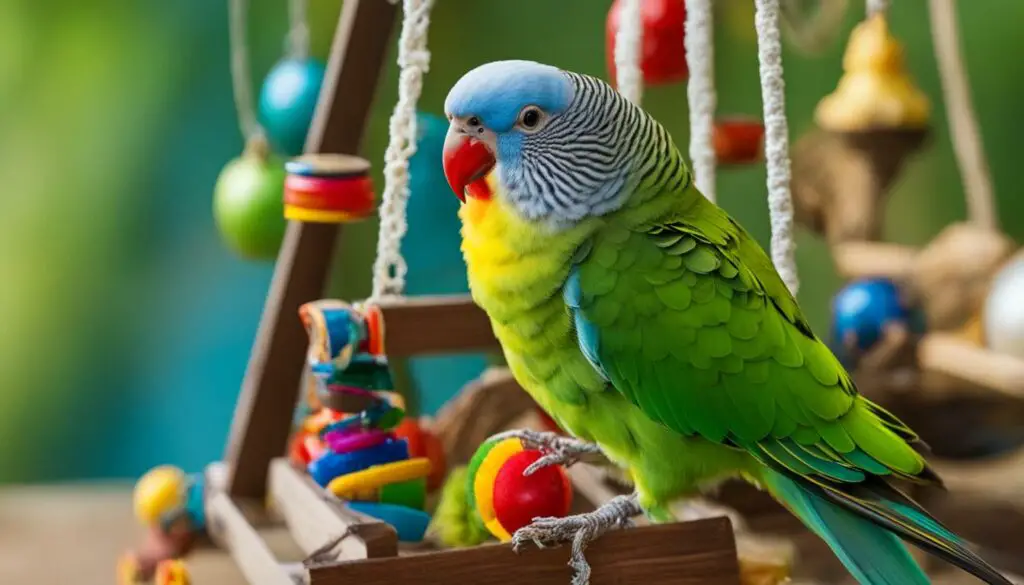
| Toy | Description |
|---|---|
| Puzzle Toys | Toys that challenge the parakeet’s problem-solving skills with hidden compartments or treats. |
| Interactive Swings | Swings with additional hanging toys or bells that provide exercise and entertainment for the parakeet. |
| Mirrors and Reflection Toys | Toys that mimic the presence of other parakeets and provide companionship for sociable birds. |
Can Parakeets Learn to Play Fetch?
Yes, parakeets can learn to play fetch! It may seem surprising, but these intelligent and trainable birds can be taught this fun and engaging trick. Teaching your parakeet to play fetch requires patience, consistency, and positive reinforcement. Here’s how you can start training your budgie to fetch:
- Choose a lightweight ball or toy that your parakeet can easily hold in its beak.
- Gently toss the ball a short distance in front of your parakeet.
- Encourage your parakeet to pick up the ball by using a verbal cue like “fetch” or “go get it”.
- When your parakeet picks up the ball, use a clicker or verbal praise to mark the desired behavior.
- Hold out your hand and encourage your parakeet to bring the ball back to you.
- When your parakeet brings the ball back, reward it with a small treat as a positive reinforcement.
Repeat these steps consistently, gradually increasing the distance of the toss, and reinforcing the behavior with treats and praise. With practice and repetition, your parakeet will learn to associate the verbal cue and the act of fetching the ball with positive rewards.
Remember, each parakeet is unique, and the time it takes to learn the trick may vary. Be patient, keep training sessions short and enjoyable, and always end on a positive note. Fetch can be a great way to bond with your parakeet and provide mental stimulation.
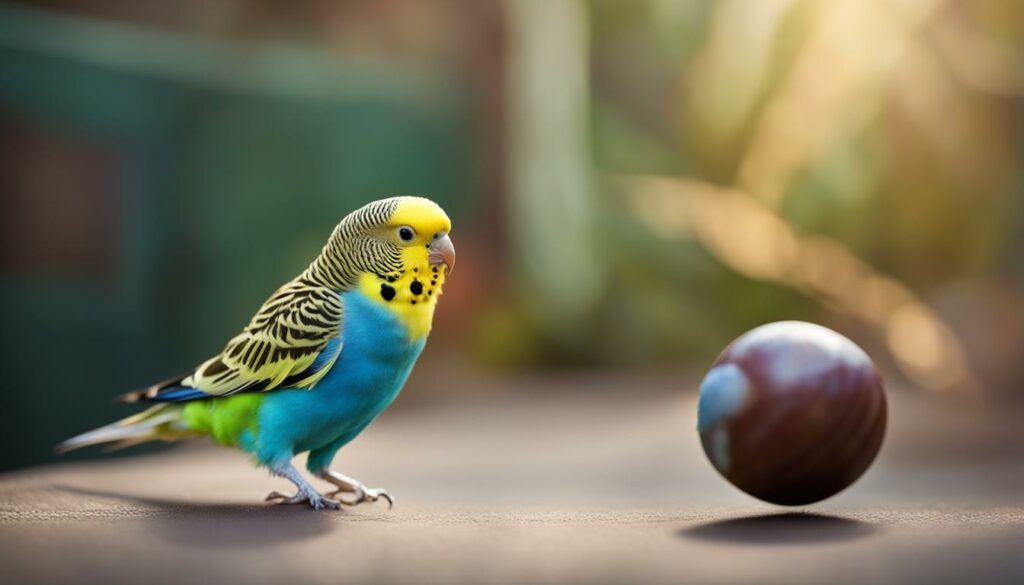
Training Tips:
Here are a few tips to enhance your parakeet’s training experience:
- Use high-value treats, such as small pieces of fruits or vegetables, to motivate your parakeet during training sessions.
- Keep training sessions short and frequent, as parakeets have shorter attention spans.
- Choose a quiet and distraction-free environment for training to help your parakeet focus.
- Be consistent with your cues and reward timing to avoid confusion.
- Always end training sessions on a positive note, even if progress is slow.
Music Suggestions for Parakeets
If you’re looking to create a stimulating environment for your parakeet, incorporating music into their daily routine can be a great way to engage their senses and provide them with entertainment. Parakeets have distinct preferences when it comes to music, and choosing the right songs can help keep them happy and engaged. Here are some music suggestions that are known to be popular among parakeets:
Upbeat and High-Pitched Music
Parakeets are often drawn to music with a fast tempo and high-pitched sounds. Songs with lively beats and catchy melodies can capture their attention and get them tapping their feet. Consider choosing songs from genres like pop, electronic, or classical, which often feature the energetic qualities that parakeets enjoy. Avoid music with heavy bass or loud, abrasive sounds, as they might be too intense for your feathered friend.
“My parakeet, Sunshine, absolutely loves it when I play classical music for her. She gets so excited and starts chirping along with the melodies. It’s such a joy to see her bopping her head and moving to the rhythm!” – Parakeet owner
Bird Sounds and Parakeet Calls
Another interesting way to engage your parakeet is to play music that incorporates bird sounds or parakeet calls. This can help stimulate their natural instincts and create a more immersive environment for them. Look for songs or recordings that feature chirping birds, tweeting sounds, or parakeet vocalizations. This can make your parakeet feel more connected to their natural habitat and provide them with a sense of comfort and familiarity.
Creating a Musical Playlist
To keep your parakeet entertained, create a playlist of songs that align with their preferences. Mix up the genres and styles to provide variety and keep things interesting. You can also observe your parakeet’s reaction to different songs and adjust the playlist based on their preferences. Remember to play the music at a reasonable volume, as loud sounds can be overwhelming for your bird.
By incorporating music into your parakeet’s daily routine, you can provide them with an enriching and enjoyable experience. Whether it’s dancing to an upbeat tune or listening to the sounds of their bird counterparts, music can add an extra dimension of stimulation to your parakeet’s life.
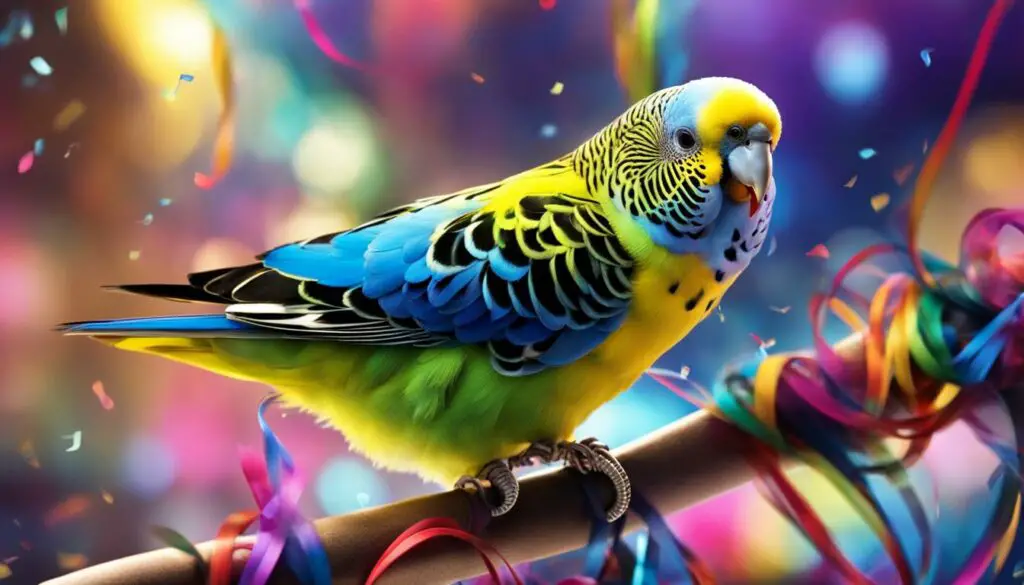
Preventing Boredom in Parakeets
Boredom can negatively impact the well-being of parakeets, leading to destructive behavior and potential health issues. As responsible pet owners, it is important to provide our feathered friends with a stimulating environment and opportunities for enrichment. By understanding the signs of boredom and implementing effective prevention strategies, we can ensure that our parakeets lead happy and fulfilling lives.
Signs of Boredom in Parakeets
It is essential to be aware of the signs that indicate our parakeets may be experiencing boredom. Excessive preening, feather plucking, and chewing on cage bars are common behaviors that may indicate a lack of mental stimulation. Additionally, a lack of interest in toys or a general lack of enthusiasm can be signs that our parakeets are not sufficiently engaged.
To prevent boredom, it is important to create an enriching environment that caters to their natural instincts and behaviors.
Budgie Enrichment Ideas
There are several enrichment activities and strategies that can keep our parakeets entertained and stimulated. Here are some ideas to prevent boredom:
- Rotate toys regularly to provide variety and maintain their interest. Introduce new toys and remove old ones to keep the environment fresh.
- Provide foraging opportunities by hiding food or treats in puzzle toys or placing them in different parts of the cage. This encourages active problem-solving and engages their natural foraging instincts.
- Offer branches or natural perches of different textures for them to explore and chew on. This not only provides physical exercise but also aids in keeping their beaks healthy and trimmed.
Creating a Stimulating Environment
Creating a stimulating environment is crucial to prevent boredom in parakeets. Besides toys and foraging opportunities, consider incorporating elements such as swings, bells, and mirrors. These accessories provide additional mental and physical stimulation, promoting a more engaging and enriching environment for our feathered companions.
Remember, each parakeet is unique, so it’s essential to observe their preferences and adjust the enrichment activities accordingly. By actively preventing boredom, we can ensure our parakeets lead happy, healthy, and fulfilling lives.
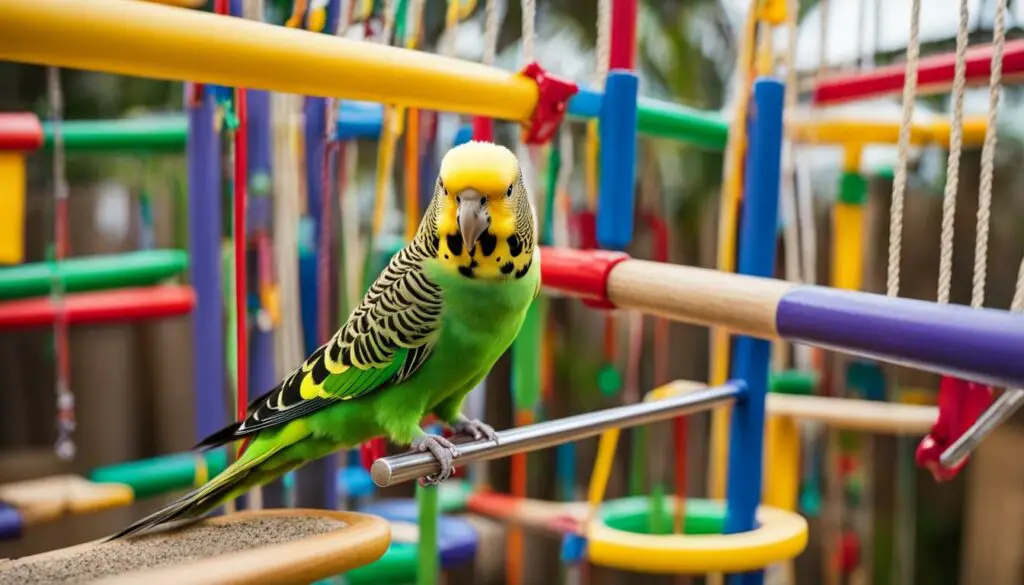
Bonding with Your Parakeet
Bonding with your parakeet is a wonderful way to establish trust, strengthen your relationship, and create a loving home environment. By dedicating time and effort to your bird’s well-being, you can build a deep bond that will last a lifetime. Here are some tips to help you bond with your parakeet:
- Spend quality time together: Interact with your parakeet daily, talking to them in a calm and soothing voice. Sit near their cage or play area and read a book, watch TV, or simply observe their activities. Make sure you are present and engaged, allowing your parakeet to become comfortable in your presence.
- Offer treats and rewards: Treats are a great way to build trust and positive associations with you. Start by offering your parakeet small pieces of their favorite fruits, vegetables, or seeds from your hand. Allow them to approach you and take the treats at their own pace. Over time, they will associate you with positive experiences and look forward to your presence.
- Play games and provide enrichment: Engage your parakeet in interactive playtime activities, such as playing with toys or teaching them simple tricks. Offer a variety of toys that stimulate their natural instincts and provide mental stimulation. Rotate their toys regularly to keep them engaged and interested.
- Respect their boundaries: Each parakeet has its own unique personality and comfort level. Respect your bird’s boundaries and don’t force interactions or handling if they are not ready. Give them space when needed and let them come to you when they feel comfortable.
Remember, bonding takes time and patience. It’s essential to approach the process with a gentle and understanding mindset. Every small step forward is a significant achievement in building trust and a strong bond with your parakeet. Be consistent, offer love and care, and enjoy the journey of creating a beautiful connection with your feathered friend.
Quotes:
“The bond between a parakeet and its owner is built on trust, love, and mutual respect. Take the time to understand your bird’s needs and preferences, and you will have a companion that brings joy and happiness to your life.” – Budgie Lover 123
“Bonding with my parakeet has been an incredibly rewarding experience. From the first day we brought him home, he became a part of our family. Now, he eagerly flies to my shoulder, chirping happily and snuggling close. The trust we’ve built is priceless.” – Feathered Friend Adventures
Table: Favorite Treats for Parakeets
| Treat Type | Description |
|---|---|
| Fresh Fruit | Small pieces of apple, banana, or grape |
| Fresh Vegetables | Carrot, broccoli, or leafy greens |
| Seeds and Millet | Millet spray or a mix of seeds |
| Herbs | Parsley, cilantro, or basil |
| Grains | Cooked rice, quinoa, or whole wheat pasta |
Remember to offer treats in moderation and provide a balanced diet for your parakeet. Always consult with a veterinarian for specific dietary recommendations for your feathered friend.
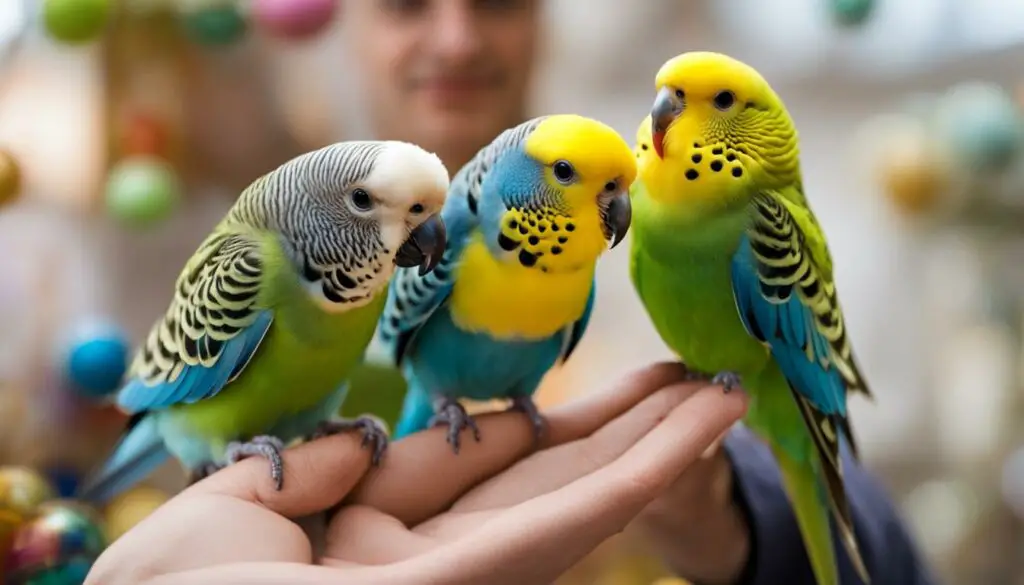
Teaching Tricks to Parakeets
Teaching tricks to your parakeet can be a rewarding and enjoyable experience for both you and your feathered friend. Not only does it provide mental stimulation and entertainment, but it also strengthens the bond between you. Here are some tips and trick ideas to get you started on your training journey.
Tip 1: Start with Basic Commands
Begin with simple commands that your parakeet can easily grasp, such as stepping up onto your finger or eating from your hand. Use positive reinforcement by offering a treat and praising them when they successfully follow the command. Repeat the training sessions daily, keeping them short and enjoyable, to help reinforce the behavior.
Tip 2: Use Clicker Training
Clicker training can be a helpful tool in teaching tricks to parakeets. Start by associating the clicking sound of a clicker with a treat. Then, use the clicker to mark the desired behavior as your parakeet performs the trick. Follow with a reward and praise to reinforce the behavior. Clicker training helps to bridge the communication gap between you and your parakeet and facilitates effective training.
Tip 3: Gradually Increase the Difficulty
Once your parakeet has mastered the basic commands, gradually introduce more complex tricks. For example, you can teach them to fly to a specific spot, respond to verbal commands, or even play basketball by pushing a small ball into a mini hoop. Remember to be patient and not move too quickly. Break down the trick into smaller steps and reward your parakeet for each successful attempt.
Tip 4: Keep Training Sessions Fun and Varied
Make training sessions enjoyable for your parakeet by incorporating fun elements and varying the tricks. Use interactive toys, such as puzzle feeders or treat balls, to add excitement. Teach your parakeet new tricks regularly to keep their mind engaged and prevent boredom. By keeping the training sessions light-hearted and rewarding, your parakeet will look forward to learning new tricks with you.
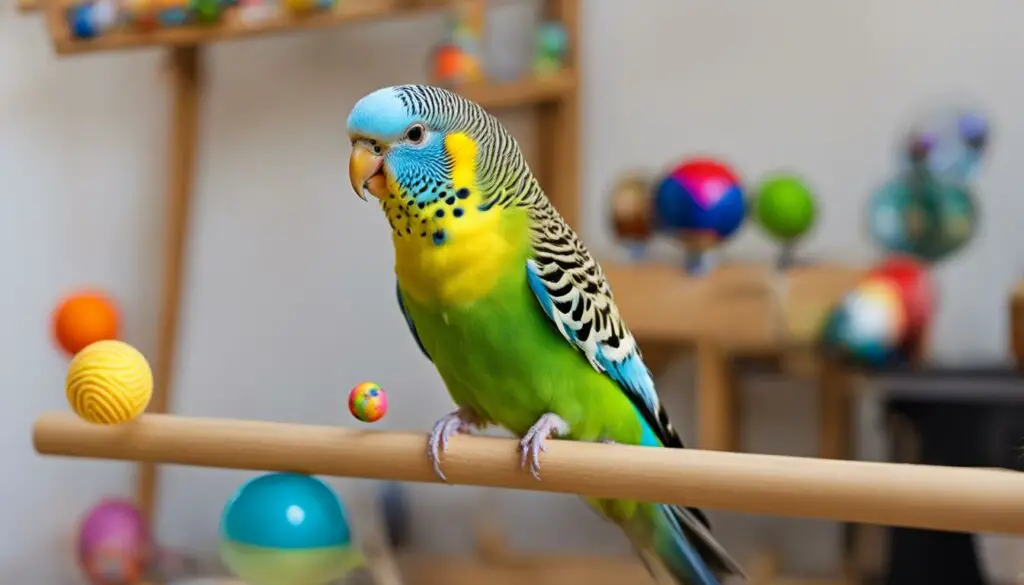
| Trick | Description |
|---|---|
| Stepping up | Teach your parakeet to step up onto your finger or a perch on command. |
| Turn around | Train your parakeet to spin in a circle. |
| Fetching | Teach your parakeet to fetch and return a lightweight toy or ball. |
| Waving | Train your parakeet to wave its foot in response to a verbal cue or hand signal. |
| Basketball | Set up a mini basketball hoop and teach your parakeet to push a small ball into it. |
Remember to be patient, consistent, and use positive reinforcement during the training process. Every parakeet is unique, so adjust your training techniques to suit their personality and learning style. With time and effort, you’ll be amazed at the tricks your parakeet can learn and the special bond you’ll develop.
Conclusion
In conclusion, providing engaging playtime activities for your budgie is crucial for their overall well-being. By incorporating a variety of options, such as foraging, climbing and perching, socialization and training, playful accessories, and out of cage time, you can keep your budgie happy, healthy, and mentally stimulated.
Foraging is a natural and interactive activity that encourages exploration and mental stimulation. Climbing and perching opportunities, along with the use of ladders and rope bridges, will keep your budgie physically active. Socialization, training, and interaction with other birds are important for their social needs.
Adding playful accessories like swings, mirrors, and bells can provide additional entertainment for your budgie. However, always supervise interactions with mirrors and ensure the safety of these accessories. Allowing your budgie plenty of out of cage time to fly and explore new environments is also vital.
Creating a stimulating environment with a variety of toys, perches, and natural elements will keep your budgie entertained. Remember, parakeets have their favorite toys like bells, swings, mirrors, and puzzle toys that offer them challenge and mental stimulation. Music with a fast tempo and high-pitched sounds can also be enjoyable for them.
Preventing boredom is essential to avoid destructive behavior. Regular playtime, changing the environment, and providing social interaction can help prevent boredom. Finally, bonding with your parakeet through treats, games, and positive reinforcement is crucial for a strong relationship.
By following these playtime activity ideas, you can ensure that your budgie remains happy, healthy, and mentally stimulated, leading to a fulfilling and joyful pet-owner relationship.
FAQ
What are some fun and engaging budgie playtime activity ideas?
Some fun and engaging playtime activity ideas for budgies include foraging, climbing and perching, socialization and training, adding playful accessories, providing out of cage time, and creating a stimulating environment.
How can I encourage foraging in my budgie?
You can encourage foraging by hiding small pieces of food around their cage or play area and using foraging toys, such as puzzle feeders.
What types of toys are good for budgie climbing and perching?
Budgies enjoy a variety of perches of different sizes and textures, as well as ladders and rope bridges.
How can I socialize and train my budgie?
Spend time with your budgie, train them to do simple tricks, and provide opportunities for them to interact with other birds.
What playful accessories are safe for budgies?
Small swings, mirrors, and bells are popular and safe playful accessories for budgies.
How can I provide out of cage time for my budgie?
Allow them supervised time outside their cage or take them for walks on a harness and leash.
What should I include in a stimulating environment for my budgie?
Provide a variety of toys, perches, and items to explore, as well as natural elements like branches, leaves, and rocks.
What are some favorite toys for parakeets?
Parakeets enjoy interactive toys such as swings, ladders, bells, mirrors, and puzzle toys.
Can parakeets learn to play fetch?
Yes, parakeets can learn to play fetch with patience and consistency in training.
What kind of music do parakeets enjoy?
Parakeets enjoy music with a fast tempo and high-pitched sounds, and you can also play music with bird sounds or parakeet calls to simulate a natural environment.
How can I prevent boredom in my parakeet?
Prevent boredom by providing new toys, changing the environment, offering social interaction, and creating a routine for your budgie.
How can I bond with my parakeet?
Spend time talking to your bird, offering treats, playing games, and using patience, consistency, and positive reinforcement to build trust and strengthen the bond.
How can I teach tricks to my parakeet?
Start with simple tricks using treats as rewards, and gradually progress to more complex tricks as your parakeet becomes more advanced in training.

